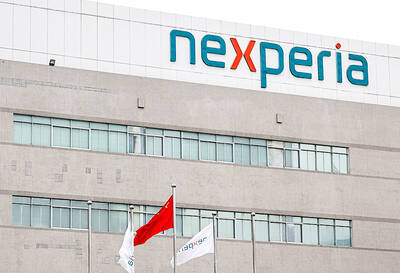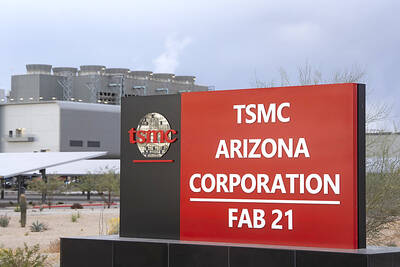The price of liquid-crystal-display (LCD) panels for computer monitors may experience its first uptick in six months this month, with inventory demand exceeding supply because of widespread production cuts, market researcher DisplaySearch said yesterday.
That would be good news for distressed LCD panel manufacturers weathering the longest slump in the history of the LCD industry, the Austin, Texas-based researcher said in a report yesterday.
Prices for 19-inch wide-format and 18.5-inch wide-format panels for PC monitors may bounce back by US$3 to US$5 per unit this month from last month, DisplaySearch said.
Flat panel makers are declining to sell panels for below the cost of production amid mounting losses, the researcher said.
Prices for notebook and LCD TV panels were expected to hold steady this month, ending a six-month downward spiral, it said.
“The stabilization of panel prices is not because of a surge in demand, but rather due to several reasons,” David Hsieh (謝勤益), a DisplaySearch vice president based in Taipei, said in the report.
“Panel makers are holding capacity utilization to low levels and some plan to cut production further in January,” Hsieh said.
Manufacturers are unable immediately to resume production at unused facilities to fill rush orders from customers, who are unwilling to keep as much inventory as usual in expectation of falling consumer spending, he said.
Speculation has circulated that the supply of 22-inch wide-format panels for LCD monitors was becoming constrained as output has decreased, he said.
In a separate report issued earlier last month, DisplaySearch said Taiwanese panel makers had lowered capacity utilization to below 60 percent this quarter from nearly 100 percent in the second quarter.
South Korean manufacturers cut equipment utilization to less than 80 percent, it said.
“Panel makers are expecting the panel prices to rebound at least back to the cash cost level to prevent further bleeding, which jeopardizes their survival,” Hsieh said.
In addition, panel suppliers have started rejecting orders that offer a unit price lower than production costs, the report said.
“Since there are not any significant increases in demand, it is not clear if price increases are sustainable. But for the panel makers, this seems like the first ray of hope in a long time,” Hsieh said.
The nation’s two largest LCD panel makers, AU Optronics Corp (友達光電) and Chi Mei Optoelectronics Corp (奇美電子) may see losses of NT$12 billion and NT$16 billion this year, based on a forecast by Yuanta Securities (元大證券).
AU Optronics posted a net income of NT$48.2 billion in the first three quarters of last year and Chi Mei, NT$25.1 billion.
Nomura Securities said in a report earlier this week that it cut its earnings estimates for AU Optronics, although the maker of LCD panels was likely to survive the economic downturn because of its strong financial status.
Nomura analyst Sean Wu (吳翔) wrote in the report that AU Optronics would lose NT$7.88 a share this year — up from his previous forecast of NT$2.45. He predicted Chi Mei would lose NT$7.7 a share this year, compared with NT$4.42 estimated previously.
The brokerage maintained a “neutral” rating on shares of AU Optronics, but cut the target price from NT$22 to NT$21.5.
Nomura downgraded Chi Mei’s shares to a “reduce” rating and said a fair price for the stock was NT$6.8.
Shares of AU Optronics dropped 59.4 percent last year to end at NT$24.7 on Wednesday, while shares of Chi Mei plunged 75.4 percent to NT$10.8 over the same period, the Taiwan Stock Exchange’s tallies showed.

JITTERS: Nexperia has a 20 percent market share for chips powering simpler features such as window controls, and changing supply chains could take years European carmakers are looking into ways to scratch components made with parts from China, spooked by deepening geopolitical spats playing out through chipmaker Nexperia BV and Beijing’s export controls on rare earths. To protect operations from trade ructions, several automakers are pushing major suppliers to find permanent alternatives to Chinese semiconductors, people familiar with the matter said. The industry is considering broader changes to its supply chain to adapt to shifting geopolitics, Europe’s main suppliers lobby CLEPA head Matthias Zink said. “We had some indications already — questions like: ‘How can you supply me without this dependency on China?’” Zink, who also

Taiwan Semiconductor Manufacturing Co (TSMC, 台積電) received about NT$147 billion (US$4.71 billion) in subsidies from the US, Japanese, German and Chinese governments over the past two years for its global expansion. Financial data compiled by the world’s largest contract chipmaker showed the company secured NT$4.77 billion in subsidies from the governments in the third quarter, bringing the total for the first three quarters of the year to about NT$71.9 billion. Along with the NT$75.16 billion in financial aid TSMC received last year, the chipmaker obtained NT$147 billion in subsidies in almost two years, the data showed. The subsidies received by its subsidiaries —

The number of Taiwanese working in the US rose to a record high of 137,000 last year, driven largely by Taiwan Semiconductor Manufacturing Co’s (TSMC, 台積電) rapid overseas expansion, according to government data released yesterday. A total of 666,000 Taiwanese nationals were employed abroad last year, an increase of 45,000 from 2023 and the highest level since the COVID-19 pandemic, data from the Directorate-General of Budget, Accounting and Statistics (DGBAS) showed. Overseas employment had steadily increased between 2009 and 2019, peaking at 739,000, before plunging to 319,000 in 2021 amid US-China trade tensions, global supply chain shifts, reshoring by Taiwanese companies and

At least US$50 million for the freedom of an Emirati sheikh: That is the king’s ransom paid two weeks ago to militants linked to al-Qaeda who are pushing to topple the Malian government and impose Islamic law. Alongside a crippling fuel blockade, the Group for the Support of Islam and Muslims (JNIM) has made kidnapping wealthy foreigners for a ransom a pillar of its strategy of “economic jihad.” Its goal: Oust the junta, which has struggled to contain Mali’s decade-long insurgency since taking power following back-to-back coups in 2020 and 2021, by scaring away investors and paralyzing the west African country’s economy.